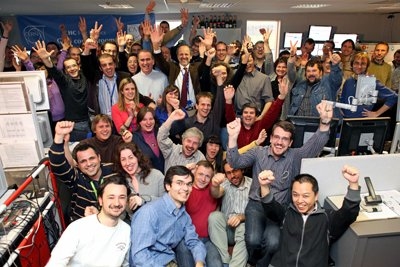The Large Hadron Collider is the world’s largest and highest-energy particle accelerator — a 17-mile loop under the Franco-Swiss border that was built by the European Organization for Nuclear Research (CERN) to help scientists answer some of the most fundamental questions in physics.Scientists fired the first beam through the collider in September 2008, but it was not until last week that that the LHC research program formally began. On Tuesday, March 30, scientists sent particles through the LHC and smashed them into one another at a total force of seven Tera electron volts (TeV) — an energy level three-and-a-half times that achieved at any other particle accelerator.
The LHC is expected to run for the next 18 to 24 months, generating data that physicists hope will reveal insights into dark matter, new forces and new particles, including the elusive Higgs boson. Markus Klute, MIT assistant professor of physics and member of the team running one of the detectors at the LHC, describes the scene when the seven-TeV collisions began.
By 5 a.m. the CMS (Compact Muon Solenoid) control center was packed with scientists monitoring and operating the CMS detector and the trigger and computing systems. Two failed attempts at 6 a.m. and 8 a.m. caused by a problem in one LHC magnet and a newly designed protection system only heightened the tension. The physicists in the detector control rooms prepared for a long day, but the third attempt to accelerate and collide protons succeeded, and first collisions were reported at 12:58 p.m. The applause and cheers lasted several minutes, and the relief was palpable. Almost instantly, the first event displays showing the collisions appeared in the control room, and minutes later first results using reconstructed data were discussed.
As CERN Director General Rolf Heuer put it Tuesday afternoon in a press conference, “It’s a great day to be a particle physicist. A lot of people have waited a long time for this moment, but their patience and dedication is starting to pay dividends.”
With the first high-energy collision, a new era in particle physics begins. The LHC will deliver enough collisions at seven TeV within the next two years to enable significant advances in a number of research areas. Particle physicists aren't certain what surprises the LHC will uncover, but they do know that new discoveries are hidden at the energy scale tested by the LHC experiments.
The LHC is expected to run for the next 18 to 24 months, generating data that physicists hope will reveal insights into dark matter, new forces and new particles, including the elusive Higgs boson. Markus Klute, MIT assistant professor of physics and member of the team running one of the detectors at the LHC, describes the scene when the seven-TeV collisions began.
By 5 a.m. the CMS (Compact Muon Solenoid) control center was packed with scientists monitoring and operating the CMS detector and the trigger and computing systems. Two failed attempts at 6 a.m. and 8 a.m. caused by a problem in one LHC magnet and a newly designed protection system only heightened the tension. The physicists in the detector control rooms prepared for a long day, but the third attempt to accelerate and collide protons succeeded, and first collisions were reported at 12:58 p.m. The applause and cheers lasted several minutes, and the relief was palpable. Almost instantly, the first event displays showing the collisions appeared in the control room, and minutes later first results using reconstructed data were discussed.
As CERN Director General Rolf Heuer put it Tuesday afternoon in a press conference, “It’s a great day to be a particle physicist. A lot of people have waited a long time for this moment, but their patience and dedication is starting to pay dividends.”
With the first high-energy collision, a new era in particle physics begins. The LHC will deliver enough collisions at seven TeV within the next two years to enable significant advances in a number of research areas. Particle physicists aren't certain what surprises the LHC will uncover, but they do know that new discoveries are hidden at the energy scale tested by the LHC experiments.






